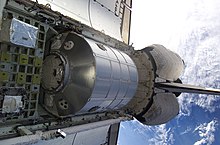
Back وحدة اللوجستيات متعددة الأغراض Arabic Многофункционален товарен модул Bulgarian Mòdul logístic multipropòsit Catalan Víceúčelový logistický modul Czech Multi-Purpose Logistics Module Danish Multi-Purpose Logistics Module German Módulos logísticos multipropósito Spanish Multi-Purpose Logistics Module Estonian ماژول لجستیک چندمنظوره Persian Multi-Purpose Logistics Module Finnish


A Multi-Purpose Logistics Module (MPLM) is a large pressurized container that was used on Space Shuttle missions to transfer cargo to and from the International Space Station (ISS). Two MPLMs made a dozen trips in the Shuttle cargo bay and initially berthed to the Unity and later the Harmony module on the ISS. Once attached, supplies were offloaded, and finished experiments and waste were reloaded. The MPLM was then transferred back into the Shuttle’s cargo bay for return to Earth. Three modules were built by Alenia Aeronautica for the Italian Space Agency (ASI). They were named Leonardo, Raffaello, and Donatello.[1]
The Leonardo module was modified in 2010 to turn it into the Permanent Multipurpose Module (PMM) and was permanently attached to the ISS during the STS-133 mission in March 2011. In July 2011, the Raffaello module was the primary payload on the final Space Shuttle mission. It returned with the Shuttle and was stored at the Kennedy Space Center. The Donatello module never launched. MPLMs were flown on 12 of the 37 Space Shuttle missions to the ISS.
The basic design of the MPLM was later used as the basis for two cargo spacecraft, the European Automated Transfer Vehicle and the American Cygnus.
- ^ "Multi-Purpose Logistics Modules". NASA. 2007.
© MMXXIII Rich X Search. We shall prevail. All rights reserved. Rich X Search